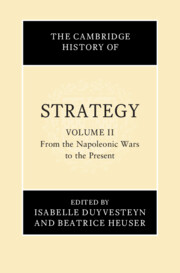Book contents
- The Cambridge History of Strategy
- The Cambridge History of Strategy
- The Cambridge History of Strategy
- Copyright page
- Dedication
- Contents
- Maps
- Contributors to Volume II
- Preface and Acknowledgements
- Introduction to Volume II
- 1 The Strategies of the Napoleonic Wars
- 2 Guerrilla and Nineteenth-Century Strategies of Insurgency
- 3 Russia, 1877–1917
- 4 The American Civil War
- 5 The Use of Naval Power
- 6 The Russo-Japanese War
- 7 Chinese Strategy, 1926–1949
- 8 First World War
- 9 Soviet Strategy, 1917–1945
- 10 Air Power
- 11 The Second World War in Europe
- 12 The Second World War in the Asia–Pacific
- 13 Soviet Strategy, 1945–1989
- 14 People’s War and Wars of Decolonisation
- 15 Nuclear Strategies
- 16 America’s Way of War
- 17 The Korean War
- 18 Israel’s Wars
- 19 The India–Pakistan Confrontations
- 20 The Yugoslav War, 1991–1999
- 21 Terrorism and Insurgency
- 22 The Forty-Year War in Afghanistan
- 23 The Three Gulf Wars and Iraq
- 24 China’s Wars, 1950–2021
- Conclusion
- Further Reading
- Index
15 - Nuclear Strategies
Published online by Cambridge University Press: 06 January 2025
- The Cambridge History of Strategy
- The Cambridge History of Strategy
- The Cambridge History of Strategy
- Copyright page
- Dedication
- Contents
- Maps
- Contributors to Volume II
- Preface and Acknowledgements
- Introduction to Volume II
- 1 The Strategies of the Napoleonic Wars
- 2 Guerrilla and Nineteenth-Century Strategies of Insurgency
- 3 Russia, 1877–1917
- 4 The American Civil War
- 5 The Use of Naval Power
- 6 The Russo-Japanese War
- 7 Chinese Strategy, 1926–1949
- 8 First World War
- 9 Soviet Strategy, 1917–1945
- 10 Air Power
- 11 The Second World War in Europe
- 12 The Second World War in the Asia–Pacific
- 13 Soviet Strategy, 1945–1989
- 14 People’s War and Wars of Decolonisation
- 15 Nuclear Strategies
- 16 America’s Way of War
- 17 The Korean War
- 18 Israel’s Wars
- 19 The India–Pakistan Confrontations
- 20 The Yugoslav War, 1991–1999
- 21 Terrorism and Insurgency
- 22 The Forty-Year War in Afghanistan
- 23 The Three Gulf Wars and Iraq
- 24 China’s Wars, 1950–2021
- Conclusion
- Further Reading
- Index
Summary
Nuclear strategy as a concept defies easy characterisation. It is a contradiction in terms: such is the destructive power of many nuclear weapons that to employ them would not bring any tangible benefit, especially if the adversary could threaten nuclear retaliation. They hold so little political appeal that since 1945 nuclear weapons have not been used in conflict and are therefore effectively unusable as weapons. Moreover, the idea of a war in which only nuclear weapons are used might exist in theory but would be a remote possibility. Instead, the practice of nuclear strategy has been dominated by ideas and plans in which nuclear weapons might be used in the course of a war alongside conventional weapons. Thus, rather than a concept of ‘nuclear strategy’, a more accurate formulation would be a ‘strategy with a nuclear component’. Yet there remained utility in thinking in terms of ‘nuclear strategy’, particularly in relation to deterrence. This chapter will explore these complex dynamics in several ways. First, it will examine the strategic ideas underpinning use of the atomic bomb at the end of the Second World War. Second, it will discuss the different strategies nuclear states have devised in relation to other nuclear states. Finally, the strategies of non-nuclear states and nuclear aspirants when confronted with nuclear adversaries will be analysed.
- Type
- Chapter
- Information
- The Cambridge History of Strategy , pp. 310 - 328Publisher: Cambridge University PressPrint publication year: 2025

